In the budget 2021, the Finance minister announced that going forward assessees will get Pre-Filled ITR forms. As a step towards that direction, on 1st November 2021, the Income Tax Department had launched a new Annual Information Statement (AIS) which would eventually replace the existing Form 26AS. Presently, Form 26AS contains some specific financial transactions, TDS/TCS information, self-assessment or advance taxes paid, etc. But now, the new AIS would contain additional information like- interest, dividend, mutual fund transactions, foreign remittances, etc. (Details of Form 26AS is explained in this Article)
However, the Form 26AS would also be visible on the TRACES portal along with the AIS till it is validated and becomes completely operational. In case of any discrepancy of information or mismatch in both these platforms (Traces / AIS) then as of now, the Form 26AS details would be deemed to be valid for the purpose of filing ITR and tax compliances. (Also Read: Who should file which ITR Form?)
Let us understand what has changed and how to access and use the new Annual Information Statement (AIS) from the e-filing portal of the Income Tax website, in detail.
New Annual Information Statement- Information included:
The new Annual Information Statement (AIS) will include the information of the following key categories:
- Salary
- Rent received and paid
- Dividend
- Interest from bank accounts or other deposits, bonds or government securities, infrastructure debt funds, etc. (Also Read: How to avoid TDS on interest income?)
- Interest from income tax refund
- Rent on plant & machinery
- Winnings from lottery or crossword puzzle, Horse Race
- Receipt of accumulated balance of PF from employer (Also Read: EPF Rules you must know)
- Income and long-term capital gain from units by an offshore fund, shares, bonds, etc.
- Income of foreign institutional investors from securities
- Insurance commission
- Receipts from a life insurance policy
- Withdrawal of deposits under the national savings scheme
- Receipt of commission etc. on sale of lottery tickets
- Income in respect of units of non-resident
- Payment to non-resident sports person or sports association
- Income from investment in securitization trust
- Purchase and sale of land or building, immovable property, or vehicle
- Purchase and sale of securities and units of mutual funds (Also Read: All About Mutual Fund Taxation)
- Purchase of time deposits
- Off-market transactions
- Business receipts and expenses
- Any other Miscellaneous payment
- Cash deposits, withdrawals, and payments
- Outward foreign remittance/purchase of foreign currency (Also Read: Why is it important to fill form 15CA/CB while remitting money outside India?)
- Receipt of foreign remittance
- Foreign travel
- Debit/Credit card (Also Read: How to use credit card wisely?)
- Income distributed by Business trust, or Investment Fund
All transactions in these categories would be reported by the respective authorities, despite the value of the transaction.
However, it is important to note that, only the information available with the Income Tax Department, under all the above heads would be included. There may be other transactions as well in the respective categories which are not displayed in AIS.
How would the New AIS be useful?
- The new AIS will provide a comprehensive view of all the financial transactions done by you and reported to the Income Tax Department by different entities during a Financial Year, at a single place. This would make the process of ITR filing simple and tax compliance easier.
- Duplication of information would be eliminated and a simplified summary of all the transactions would be generated which can be used in the pre-filing of Income Tax Returns, although would be implemented in a phased manner. This summarised statement is called Taxpayer Information Summary (TIS).
- In case the information displayed on the Annual Information Statement (AIS) is inaccurate or the transaction does not relate to you or belong to any other financial year, you can submit the appropriate feedback both online as well as offline and it would be modified accordingly. Bulk feedback related to various transactions can also be submitted.
- The AIS information can be downloaded in PDF, CSV, as well as JSON format. Uploading the AIS in JSON format on the utility portal would help you to view your AIS and submit feedback offline.
- The information provided on the AIS can be easily compared with the source by the authorities to remove discrepancies and resolve errors quickly.
- This would also help in populating the PAN of the assessee in case of non-submission of PAN in the relevant information by matching Aadhar and other key attributes.
How to access the new Annual Information Statement?
The new Annual Information Statement (AIS) can be accessed through the e-filing portal on the Income Tax website and follow the steps below:
- Log in/Register to your tax filing account-
You need to visit the website using the URL- https://www.incometax.gov.in/ and log in to your account using your PAN/Aadhar and password. In case you are not registered on the portal, you need to first register yourself by providing relevant details.
- Navigate to the AIS Homepage-
On the services tab, you need to click on the Annual Information Statement (AIS) to navigate to the AIS Homepage (compliance portal).
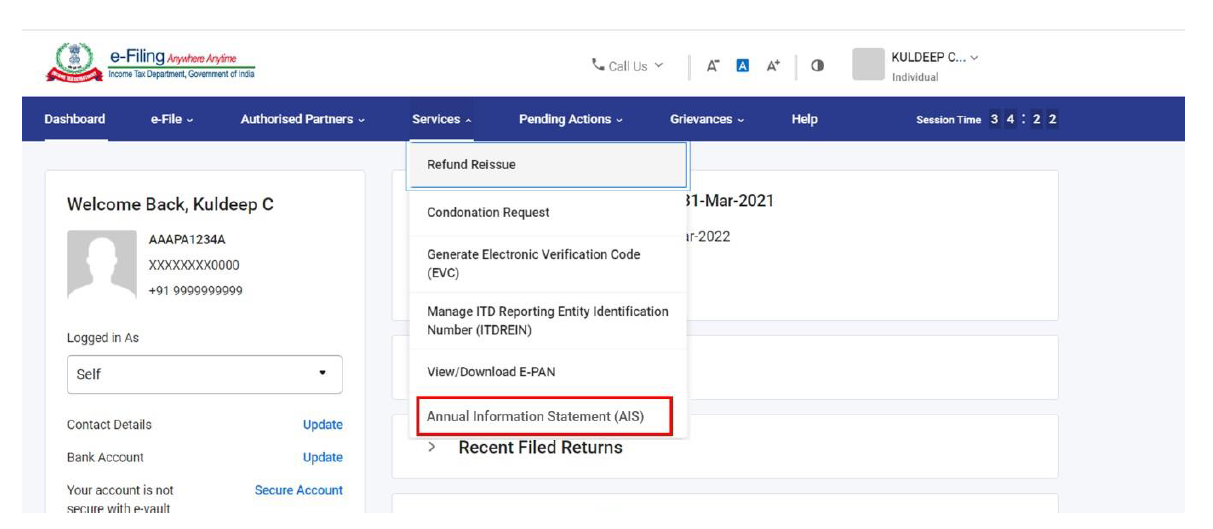
- Click on the AIS tab on the homepage.
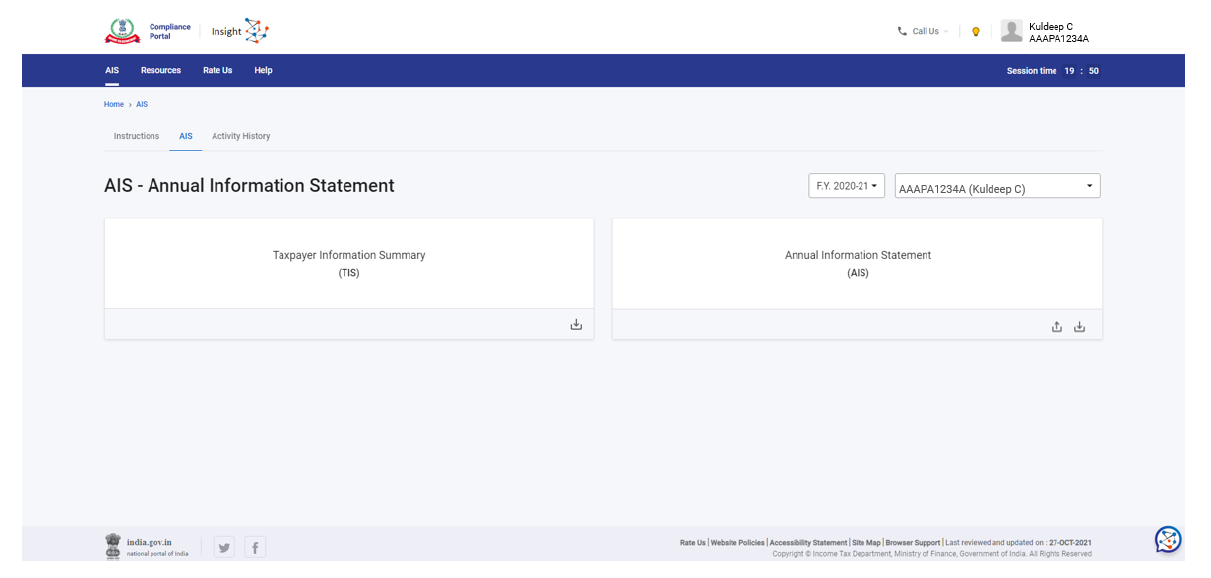
- View Your AIS Details-
Select the relevant Financial Year and PAN to view the AIS and click on the Annual Information Statement (AIS) tile to view your AIS details.
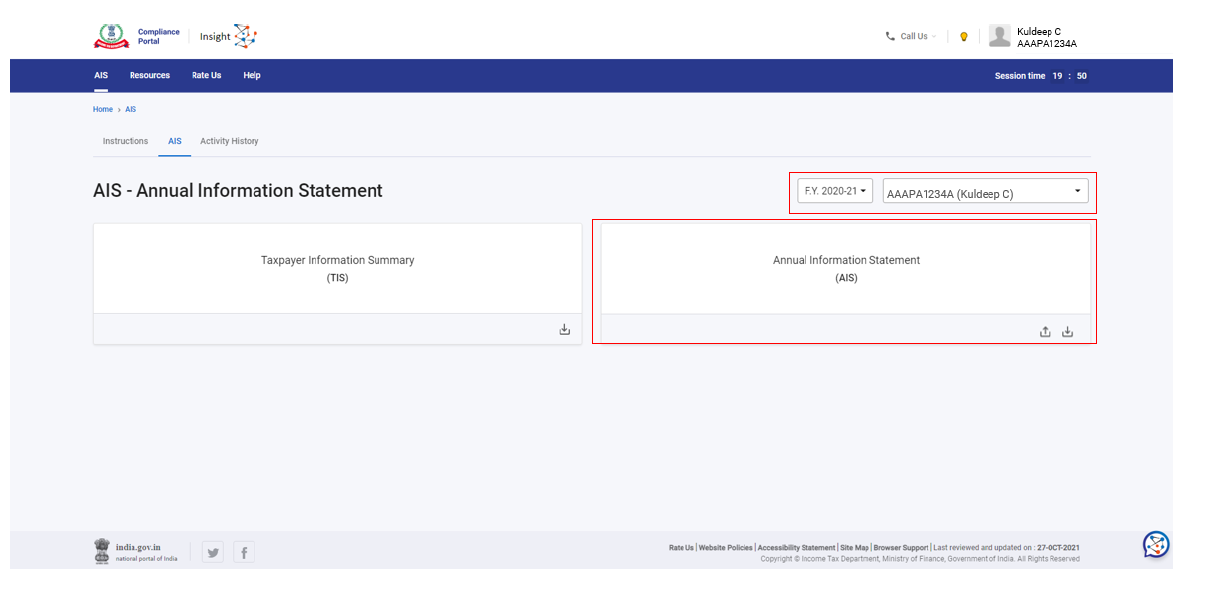
Parts in AIS:
The details on the Annual Information Statement are divided into the following two parts- PART A and PART B.
Part A: It displays general information which includes- PAN, Masked Aadhaar Number, Your name, Date of Birth, mobile number, e-mail, and address.
PART- B: It displays the following information:
- TDS/TCS Information: Information related to tax deducted/collected at source is displayed here along with the Information code of the TDS/TCS, Information description, and Information value.
- SFT Information: Under this head, information received from reporting entities under Statement of Financial transaction (SFT) is displayed, along with the SFT code, Information description, and Information value.
- Payment of Taxes: Information relating to the payment of taxes under different heads, such as Advance Tax and Self-Assessment Tax, is shown here.
- Demand and Refund: You will be able to view the details of the demand raised and refund initiated (AY and amount) during a financial year (not released yet).
- Other Information: Details of the information received from the other sources, such as data pertaining to Salary, Interest on refund, Outward Foreign Remittance/Purchase of Foreign Currency etc., is displayed here.
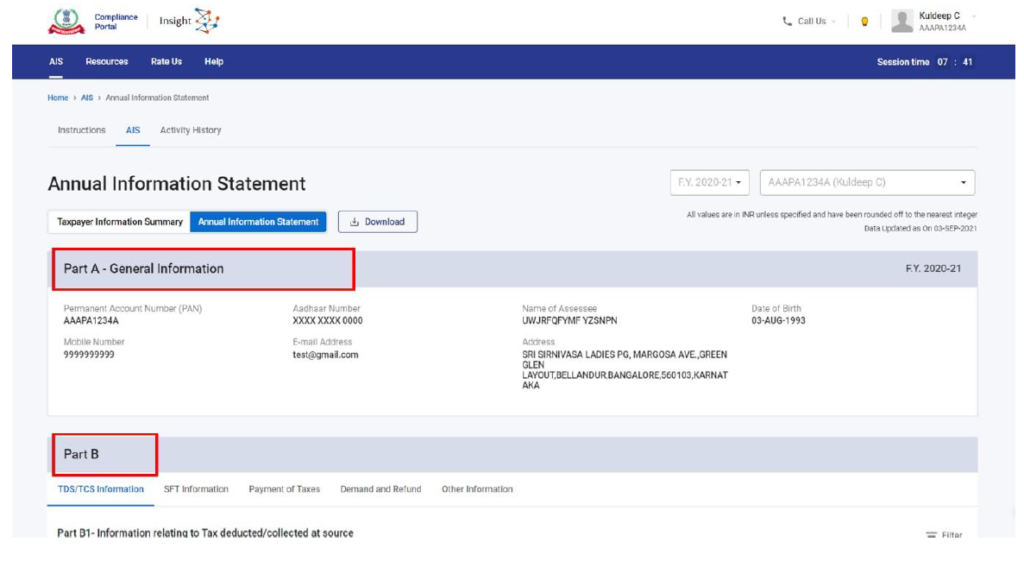
You can click on the respective information to view the further details of the transactions and source-wise aggregated details.
How to download the new Annual Information Statement?
- You can download the new Annual Information Statement by clicking on the download icon on the AIS view.
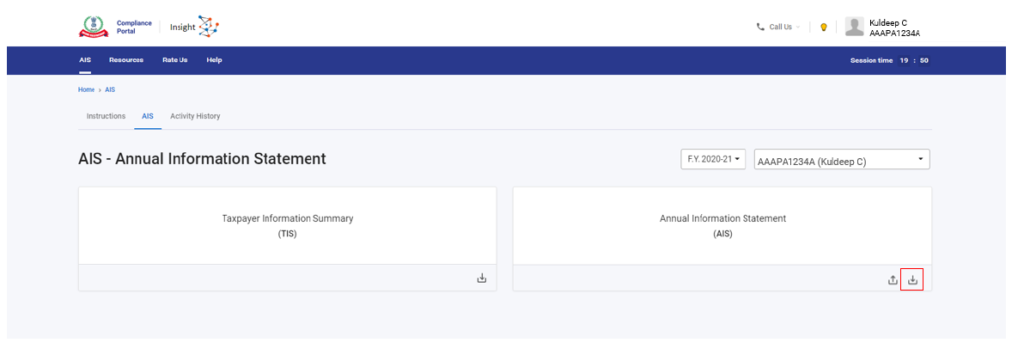
2. Now you need to select the relevant format (PDF or JSON) in which you wish to download the file. The JSON format can be used on the AIS utility portal to submit feedback on the information. The consolidated feedback can also be downloaded.
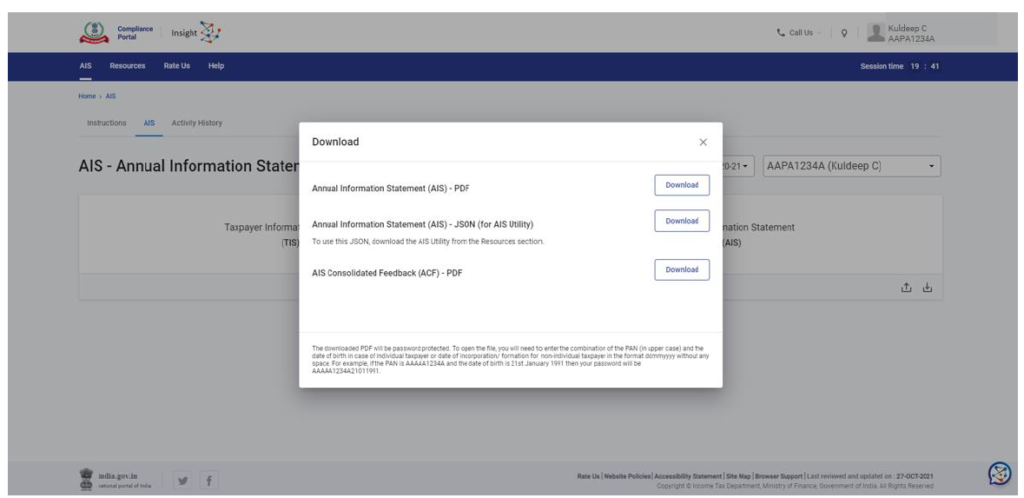
The PDF file so downloaded would be password protected. To open the file, you will need to enter the combination of your PAN (in upper case) and date of birth in the format DDMMYYYY without any space. For example, if the PAN is AAAAA1234A and the date of birth is 21st January 1991 then your password will be AAAAA1234A21011991.
You can also download the details of the specific transactions in CSV format by navigating to the AIS details and expanding the same. Click on the download icon displayed on the details window and download the CSV file.
How to submit feedback on the AIS information?
You can submit your feedback on each and every piece of information displayed on the new Annual Information Statement (AIS) details. You can navigate to the AIS details and expand the relevant information on which you want to submit your feedback.
You need to click on the “optional” button in the feedback column on the relevant information.
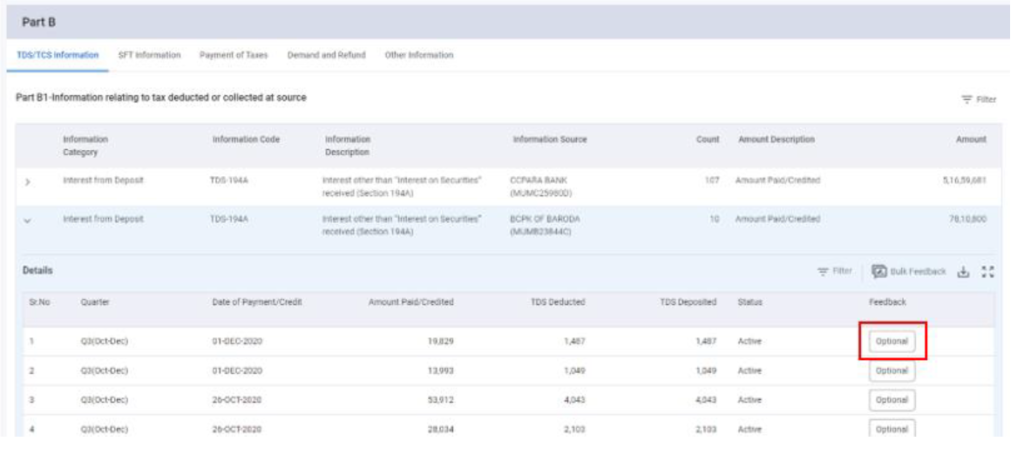
In the add feedback screen, you need to choose the appropriate feedback option. Options include-
- Information is correct
- Information is not fully correct- upon selecting this option, relevant information fields will be displayed, and you will be able to update correct information details. e.g.- Account number, Information value, etc.
- The Information relates to other PAN/year
- Information is duplicate/included in other information
- Information is denied
- Customized feedback
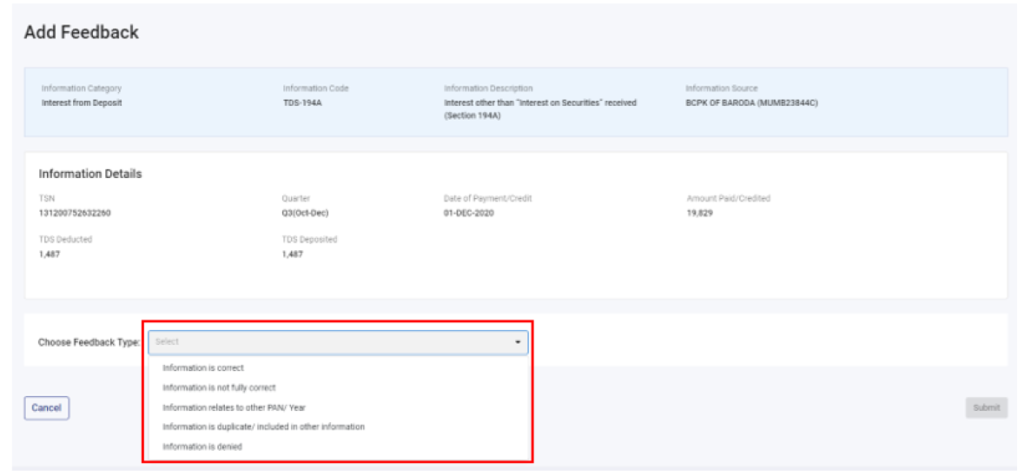
Once you select the feedback option, you need to click the “Submit” button. The following message would be displayed upon successful submission of feedback. The acknowledgment receipt of the same can be downloaded from the activity history tab.
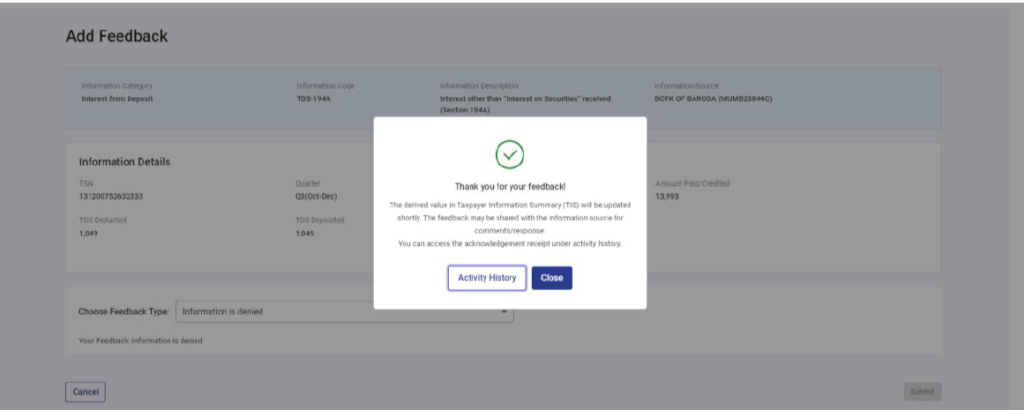
There is also an option of Bulk Feedback where you can select multiple information for which feedback needs to be provided.
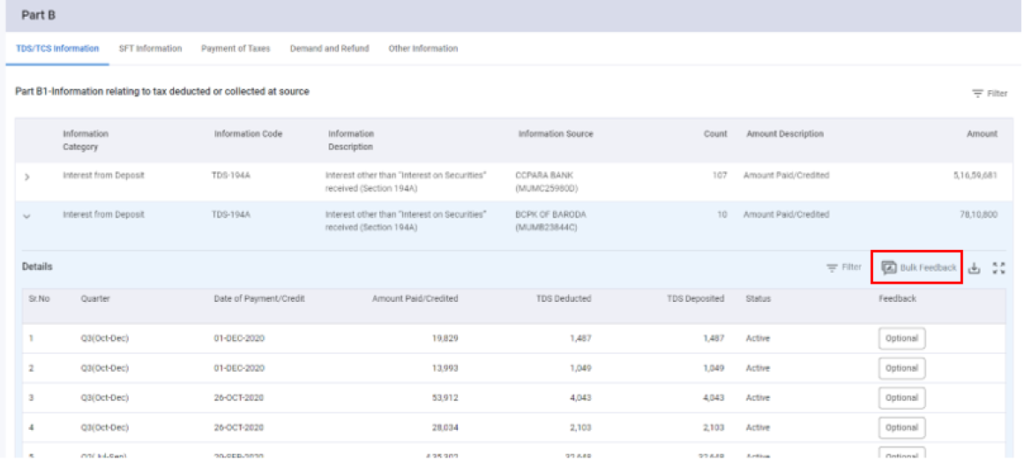
You can also modify the feedback once submitted by clicking on the Modify Feedback option. First, you need to click on the already submitted feedback that needs modification, you will find this button on the following screen. Then you need to select the reason for modification along with remarks as per the requirement.
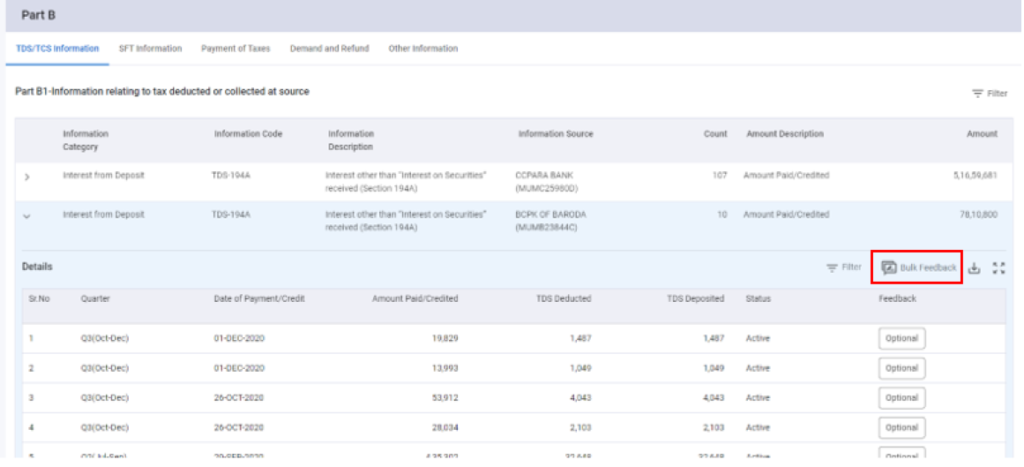
Once the feedback is submitted/modified successfully, the modified value of the information would be displayed with the reported value as per the feedback submitted. The modified value will be calculated according to the feedback type selected and the feedback details.
The system will validate the feedback, applying multiple rules to confirm the correctness of the same. Once the feedback is processed, an email and SMS notification would be sent to you.
An acknowledgment receipt would be shared with the status of the feedback whether accepted or rejected, along with the reason for rejection. You also have the option to correct the rejected feedback. You can also check the number of accepted feedbacks on the ‘Activity History’ Tab.
What is Taxpayer Information Summary (TIS)?
TIS is the information category-wise summary of all transactions of the Annual Information Statement. It contains the processed value under each category of information (after eliminating the duplicate values) and the value which is derived after considering the feedback provided. This information in the TIS will be used for the pre-filing of Returns.
In the end:
The new Annual Information Statement (AIS) is a wonderful initiative taken by the IT Department to make tax compliance easier for taxpayers and make the Income-tax return filing process seamless. The steps to access the AIS on the portal are simple and can be understood very easily. The feedback mechanism is also robust and would help in the verification of the details. (Also Read: Why is it important to file ITR on time?)
Hope this post gives you a fair idea about which transactions would be reported in the new AIS, steps to access the same online, and provide feedback on the information displayed. For further details, you may see the FAQs here.
Did you use the new AIS? Do share your experiences in the comment section below.







 Manikaran Singal is the founder and Chief financial planner at Good Moneying Financial Solutions. He is a CERTIFIED FINANCIAL PLANNER CM and SEBI registered Investment adviser (Regd no. INA 100001620). He’s having 20+ years of experience in financial services space.
Manikaran Singal is the founder and Chief financial planner at Good Moneying Financial Solutions. He is a CERTIFIED FINANCIAL PLANNER CM and SEBI registered Investment adviser (Regd no. INA 100001620). He’s having 20+ years of experience in financial services space.

